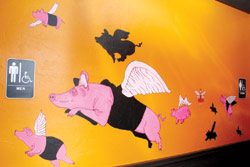Artists aren't typically thought of as entrepreneurs or purveyors of business in this culture, but local painter Gabriel Shaffer has laid that idea to rest. "Whoever came up with the myth of the starving artist wasn't an artist," he says.

By now you may have heard of Shaffer or at least seen his effusive folk-inspired paintings, either at a local craft venue or at a gallery or restaurant downtown. (Last week he exhibited work at the 37th annual Village Art and Craft Fair.) He's also exhibited in reputable folk and outsider art fairs around the country and this year has been showing at the esteemed SOFA fairs in New York City, Santa Fe and Chicago.
With his hand in so many venues, Shaffer has seen firsthand the effect the economic downturn has had on artists in the region. Like many, he first noticed a decline in art sales last summer with "full paralysis in early September." In one day, he had $8,000 worth of commissions cancelled, and others disappeared during the holiday season.
Observing panicked artists lowering their prices and producing more work to sell, Shaffer took some advice from his father, a sports memorabilia collector, who encouraged him to do the exact opposite – raise prices and produce less work. "When you decrease the value of your work you are letting people take advantage of you. By raising prices you're declaring that you're not going anywhere, and that you believe your work is worthy of investing in." Since he adopted this approach, Shaffer claims he saw a shift in his sales. "This has been my best year ever. I have sold a painting nearly every week."
Having created work that appeals to people of all economic sectors for more than five years, Shaffer says he will continue to produce drawings to sell at manageable price points ($40 to $80). His prices for larger and more detailed work, however, have increased according to an hourly rate he has determined for himself. He is now pricing work to sell from $1,000 to $15,000.

But who will be buying the work? Shaffer claims he is like a detective when it comes to finding collectors. From traveling and heightened press exposure, he's picked up a wide array of people, forming friendships and business relationships over time. "When I go into the studio it's not just about me — the collectors are a part of the work as well."
But does this at all compromise his values or make him feel resentful? "I just like making art. I don't feel like I'm catering to anyone. I'm not trying to get Nike to patent me or anything, I just want to be in a position to continue to make the art without penalizing my family and people who depend on me."
To Shaffer, a successful business model begins with a positive state of mind. "First of all, love is the source of all my art — love for my family, love for my opportunity to make it, love for the people who love it." Approaching his art in these terms, he claims, magnetically draws people to want to own it. "Passion is the thing that's gonna sell the work. If people know you care about it, they will be infected by that."
A clever twist of perspective — and one he learned from his dad — keeps Shaffer's attitude about salesmanship inflated: "I'm not here to sell my paintings, I'm here for people to buy them." His attitude implies that the work asks for its buyer rather than visa versa. "My paintings know better than I do where they are supposed to go."
So what advice can this practiced artist give to the budding visual art entrepreneurs of Asheville? "Keep painting like hell, and keep putting your work out there for the public to see. He urges artists to "learn how to deal with collectors, organize events and reinvent what's going on." One way to do this, he suggests, is to submit work to places outside of town to build up Asheville's reputation as an artistic hotspot.
On the flip side, he encourages local collectors to seek out and nurture more of Asheville's artists. "In my ideal world people would invest in artists, not stocks, because there's a real person behind the investment."
Learn more at www.gabrielshaffer.com.



This guy is my new hero. Very well deserved article, with some great positive insights.
Great article!!! I’d like to see more like this…stories about the people BEHIND the art.
Thanks
Jerry Nelson
http://www.JourneyAmerica.org